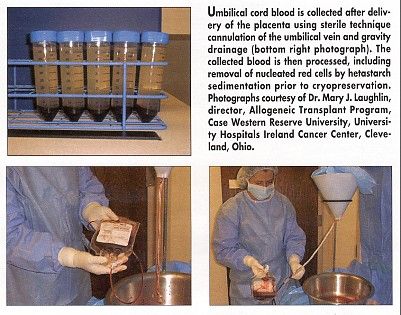Umbilical Cord Blood in Adult Leukemia Patients
SAN FRANCISCO-Umbilical cord blood from unrelated donors can be a useful source of hematopoietic stem cells for treating hematologic malignancies in adults as well as infants, according to a multicenter study presented by Mary J. Laughlin, MD, at the 42nd Annual Meeting of the American Society of Hematology (ASH). Dr. Laughlin is director of the Allogeneic Transplant Program, Case Western Reserve University, University Hospitals Ireland Cancer Center.
SAN FRANCISCOUmbilical cord blood from unrelated donors can be a useful source of hematopoietic stem cells for treating hematologic malignancies in adults as well as infants, according to a multicenter study presented by Mary J. Laughlin, MD, at the 42nd Annual Meeting of the American Society of Hematology (ASH). Dr. Laughlin is director of the Allogeneic Transplant Program, Case Western Reserve University, University Hospitals Ireland Cancer Center.
Cord blood has been used sporadically since 1988 for transplantation in children with leukemias and other blood disorders. The treatment is new in adult patients, however. The challenge with adults, Dr. Laughlin said, is their greater size and low graft cell dose received.
In the new study, 68 adult patients under the age of 55 were transplanted using HLA-mismatched unrelated donor umbilical cord blood (UCB); 54 had hematologic malignancies. Preferred UCB units were those matched at a minimum of 3 of 6 HLA loci and containing a minimum of 1 × 107/kg nucleated cells; 71% of patients received grafts disparate at 2 or more HLA antigens.
There were 8 early deaths due to infection and/or toxicity. Of 60 patients surviving more than 28 days after UCB transplantation, 55 (90%) achieved neutrophil engraftment. The researchers were able to achieve a faster rate of neutrophil recovery with a higher dose of transplanted cells.
There were 5 primary graft failures in patients who survived for more than 28 days, but so far there have been no late graft failures, Dr. Laughlin said. Probability of graft-vs-host disease (GVHD) was .60 for grade 2-4 acute GVHD, .20 for grade 3-4 acute GVHD, and .38 for chronic GVHD. Chronic GVHD was limited stage in all but one patient.
Eighteen patients remain alive with no evidence of disease for at least 48 months after transplant, for a probability of disease-free survival of .26. Four patients relapsed at 3, 6, 10, and 11 months after transplant, for a probability of relapse of .14.
The researchers thus concluded that UCB from unrelated donors can successfully engraft adult recipients with high-risk or recurrent hematologic malignancies and marrow failure syndromes. "I must emphasize," Dr. Laughlin said, "that these are phase I studies with patients who are at very high risk, multiply relapsed, etc."

Cord Blood Advantages
One of the advantages of using cord blood instead of bone marrow for transplant is that it takes far less time to find a suitable donor. "This is a tremendous advantage, particularly for patients with acute leukemias," Dr. Laughlin said. "For the vast majority of our patients, we are able to identify and mobilize a suitable unrelated graft within 3 weeks."
Despite disparities in HLA antigens between donor and recipient, the study found that unrelated UCB transplant is associated with a relatively low incidence of severe acute or chronic GVHD.
Because of the unique properties of umbilical cord blood, a less than perfect match is acceptable for the transplant to be successful, Dr. Laughlin said. This increased tolerance may be related to the unique immunology of pregnancy, which tolerates immune differences between two individuals (mother and baby) who are not genetically identical.
Umbilical cord blood transplantation may also be a better alternative to marrow transplantation because the cord blood can be collected at no risk to the donor, she added.
Giredestrant Combo Yields Positive PFS in Subgroups After CDK4/6i in ER+/HER2– Breast Cancer
December 13th 2025“The magnitude of clinical benefit was clinically meaningful and consistent, and was regardless of PIK3CA mutations or alterations in the PIK3CA pathway, duration of prior CDK4/6 inhibitors, including patients who progress within 6 to 12 months, and the choice of prior CDK4/6 inhibitors,” said Hope S. Rugo, MD.